Lyons W.C. (ed.). Standard handbook of petroleum and natural gas engineering.2001- Volume 1
Подождите немного. Документ загружается.


Drilling Bits and Downhole Tools
785
Mill tooth bits, each
$
260.00
insert bits
1,250.00
Mud, per day
500.00
Water, per day
200.00
Desilter, per day
150.00
Supervision, per day
250.00
$2,6
1
0.00
Hourly rig cost
$
108.00
Total daily cost
Trip time is 0.7 per hour per 1,000 ft.
The cost equation is
C
=
B/F
+
C,T,/F
+
CtT,/F
(4-75)
where
C
=
drilling cost per foot in $/ft
B
=
bit cost in
$
F
=
footage drilled in ft
C,
=
rig cost for drilling in $/hr
T,
=
drilling time in hr
Tt
=
trip time in hr
Cc
=
rig cost for trip in $/hr
Assumptions are
(1)
comparable lithology,
(2)
C,
=
Ct
=
$108/hr, and
(3)
the
The bit record from the offset control well is presented in Table 4-96.
The cost per foot for each bit run is calculated as follows:
Bit
No.
1
Drilling hours
=
10.5
Trip hours
=
(0.7 hr/1000 ft)(5.958
x
1000 ft)
=
4.1 hr
Total hours
=
14.6 hr
Total footage
=
160 ft
well in question is to be deepened from 6000 to 7650 ft.
Therefore.
C
=
1/F [B
+
C,(T,
+
T,)]
=
1/160 ft[$260
+
$108/hr (10.5
+
4.l)hrl
=
$11.51/ft
Table
4-96
Cost
of
Steel Tooth Bits
[34]
Bit
No
Depth out,
ft
Footage,
ft
Bottom time,
hr
1
6008
174
19.0
2 6268
260 19.5
3
6518
250 25.0
4 7444
926 99.75
5 7650
206 25.5
Copyright
PennWell
Books,
1986.
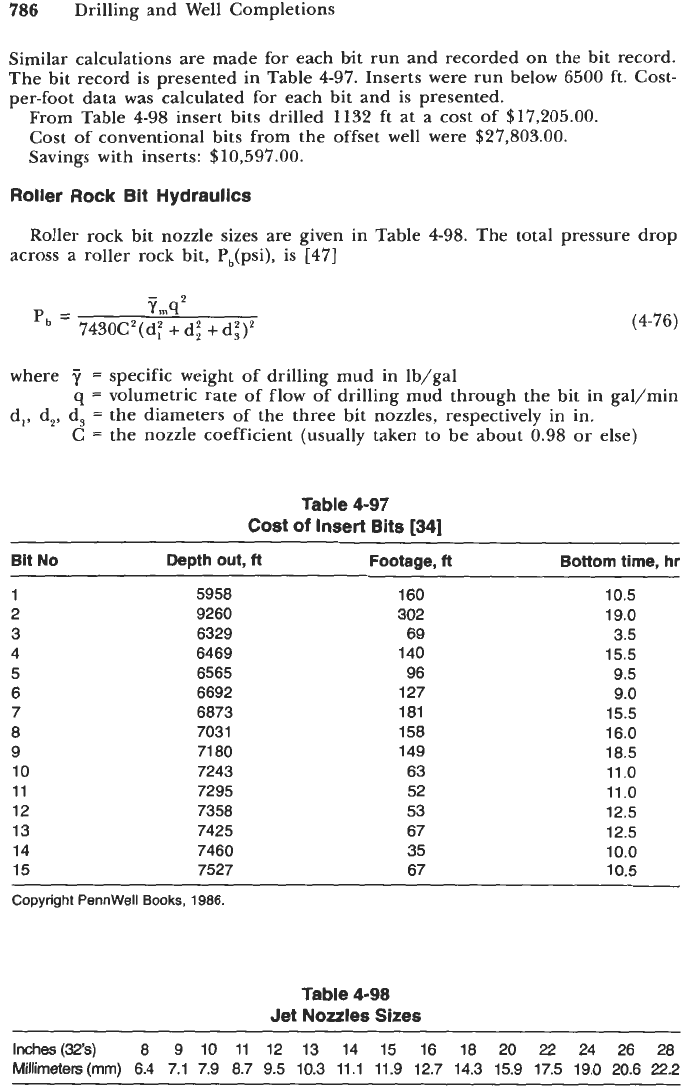
786
Drilling and Well Completions
Similar calculations are made for each bit run and recorded on the bit record.
The bit record is presented in Table 4-97. Inserts were run below 6500 ft. Cost-
per-foot data was calculated for each bit and is presented.
From Table 4-98 insert bits drilled 1132 ft at a cost of $17,205.00.
Cost of conventional bits from the offset well were $27,803.00.
Savings with inserts: $10,597.00.
Roller Rock Bit Hydraulics
Roller rock bit nozzle sizes are given in Table 4-98. The total pressure drop
across a roller rock bit, P,(psi), is [47]
P,
=
Ymq2
7430C2(d:
+
d:
+
d:)'
(4-76)
where
7
=
specific weight of drilling mud in lb/gal
d,, d,, d,
=
the diameters of the three bit nozzles, respectively in in,
q
=
volumetric rate of flow of drilling mud through the bit in gal/min
C
=
the nozzle coefficient (usually taken to be about 0.98 or else)
Table 4-97
Cost
of
Insert Bits [34]
Bit
No
Depth out,
ft
Footage,
ft
Bottom
time, hr
1
5958 160 10.5
2 9260
302 19.0
3 6329
69 3.5
4 6469
140 15.5
5 6565
96 9.5
6 6692
127 9.0
7 6873
181 15.5
8 7031
158 16.0
9 7180
149 18.5
10 7243 63 11.0
11
7295 52 11.0
12 7358
53
12.5
13 7425 67 12.5
14 7460
35 10.0
15 7527 67 10.5
Copyright
PennWell
Books,
1986.
Table 4-98
Jet Nozzles Sizes
lnches(32's)
8
9
10
11
12 13
14
15
16 18 20
22
24 26 28
Millimeters(mm) 6.4
7.1
7.9 8.7 9.5 10.3
11.1
11.9 12.7
14.3 15.9
17.5 19.0 20.6 22.2
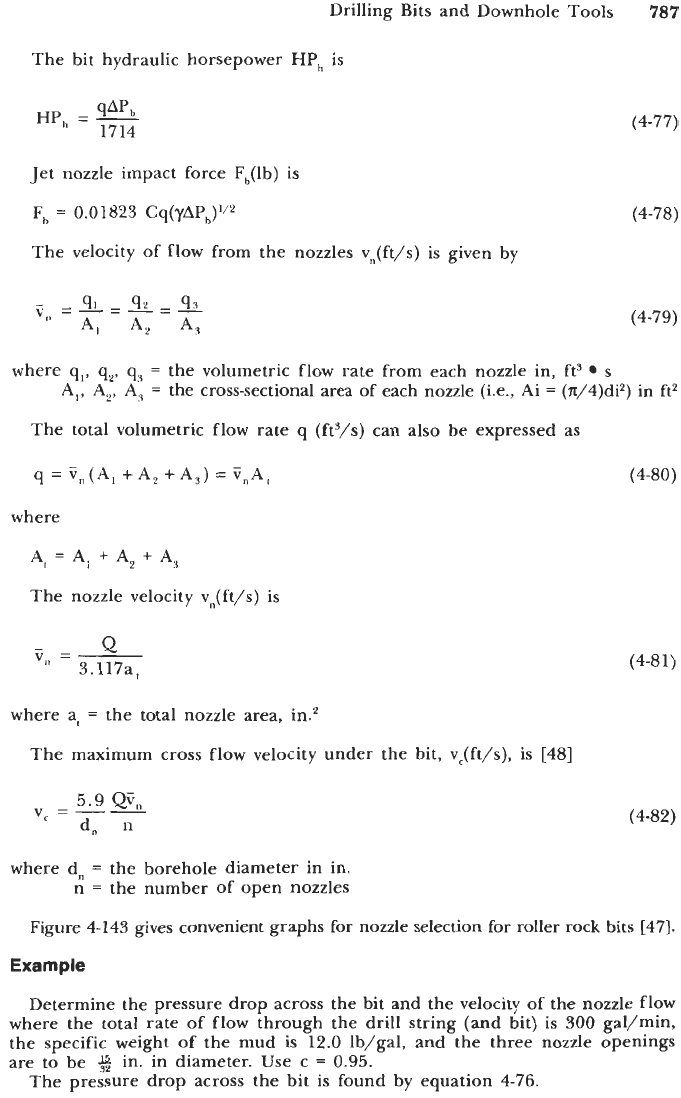
Drilling Bits and Downhole Tools
787
The bit hydraulic horsepower
HP,
is
q*P,
HP,
=
-
1714
(4-77)
Jet nozzle impact force F,(lb) is
F,
=
0.01823 Cq(yAP,)'/' (4-78)
The velocity
of
flow from the nozzles v,(ft/s) is given by
(4-79)
where
q,,
q,,
q,
=
the volumetric flow rate from each nozzle in, ft3
s
A,,
A,,
A,
=
the cross-sectional area of each nozzle (Le., Ai
=
(71/4)di2) in
ft2
The total volumetric flow rate
q
(ft'/s) can also be expressed as
q
=
V,(A,
+A,
+A,)
=
VnA,
where
A,
=
A;
+
A,
+
A,
The nozzle velocity vn(ft/s) is
-
Q
v,,
=
-
3.117a,
where at
=
the total nozzle area, in.2
The maximum cross flow velocity under the bit, vc(ft/s), is
[48]
(4-80)
(4-81)
(4-82)
where dn
=
the borehole diameter in in.
n
=
the number of open nozzles
Figure 4-143 gives convenient graphs for nozzle selection for roller rock bits
[47].
Example
Determine the pressure drop across the bit and the velocity of the nozzle flow
where the total rate of flow through the drill string (and bit)
is
300
gal/min,
the specific weight of the mud is 12.0 Ib/gal, and the three nozzle openings
are
to
be
in. in diameter. Use c
=
0.95.
The pressure drop across the bit is found by equation 4-76.

4
00
00
Nozzle Selection
Chart
for Given Drilling
Sti
&
Working Pressure With Varying Depth
&
500
400
3w
200
1M)
de-1
I
I
I1
0
.
.
..
0
%
250
s
z
500
E
m
v)
750
-
1.
loo0
c,j
a
1
lZ50
%
s
3
1750
a
z2ow
2250
2
0
Circulation
Ra&
GPM.
(US.)
-
ANNUM MLOClPl Ft./Mln.
-
,I
III
I
I.
IIJTI
I
I
I,
II II
I1
II
IIII
I
120
140
160
180
200
220
240 260
280
300
320
340
360
380
400
USED "SECURITY HYDRAULIC
CALCULATOR"
'ing, Hole Size
Mud
Density
DRILLING STRINGS:
400'
of
6
1/4"
0.0.
Drill Mlars
+5"
Extra
Hole Drill
Pipes
Hole
size:
8
1/2"
Worlting Pressure= 2250
P.S.I.
WMFW
AssurneAnnularVelocity=
230
FVmin
Mud Density= 11
IWgal
Depth=
7000'
Start
at
230
F.P.M.
Reach
'A'
(7000'
Line)
Turn for
'6'
(on
10
P.P.G.
Line)
Slant to
'C'
(on
11
P.P.G.
Line)
Slant
back
to
'D
(on
10
P.P.G.
line)
Reach
for
'E'
(on
224
F.P.M.
Line)
(Nearest higher nozzle line
to
be taken)
Nozzle set
3
x
13/32"
Follow
230
F.P.M.
Line
to
'F
Find
Jet
Velocity
(360
F.P.S.)
A
typical nozzle
program
1
x
11/32".
3x318"
Cumdrawn
for
10
1Mgal.f~
10
P.P.G.
AMwill
be
Me me
point
p1
3
a
8
e
Figure
4-143.
Bit
nozzle selection nomogram
[47].
(Courtesy
Harcouff
Brace
&
Co.)
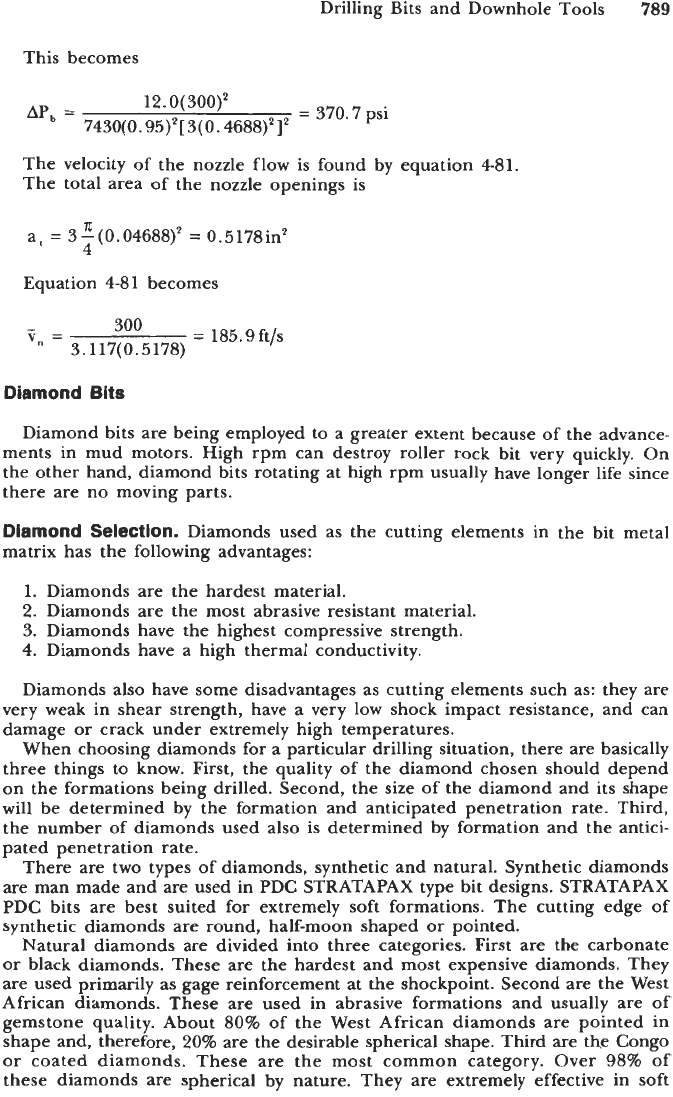
Drilling Bits and Downhole Tools
789
This becomes
APb
=
12.0(300)*
=
370.7 psi
743qO.
95)'[
3(
0.4688)']*
The velocity of the nozzle flow is found by equation 481.
The total area of the nozzle openings is
n:
a,
=
3-(0.04688)'
=
0.5178in2
Equation 4-81 becomes
4
-
v,
=
300
=
185.9 ft/s
3.1
17(
0.5
178)
Diamond Bits
Diamond bits are being employed to a greater extent because of the advance-
ments in mud motors. High rpm can destroy roller rock bit very quickly. On
the other hand, diamond bits rotating at high rpm usually have longer life since
there are no moving parts.
Diamond Selection.
Diamonds used as the cutting elements in the bit metal
matrix has the following advantages:
1. Diamonds are the hardest material.
2.
Diamonds are the most abrasive resistant material.
3.
Diamonds have the highest compressive strength.
4.
Diamonds have a high thermal conductivity.
Diamonds also have some disadvantages as cutting elements such as: they are
very
weak in shear strength, have a very low shock impact resistance, and can
damage
or
crack under extremely high temperatures.
When choosing diamonds
for
a particular drilling situation, there are basically
three things to know. First, the quality of the diamond chosen should depend
on the formations being drilled. Second, the size of the diamond and its shape
will be determined by the formation and anticipated penetration rate. Third,
the number of diamonds used also is determined by formation and the antici-
pated penetration rate.
There are two types of diamonds, synthetic and natural. Synthetic diamonds
are man made and are used in PDC STRATAPAX type bit designs. STRATAPAX
PDC bits are best suited for extremely soft formations. The cutting edge of
synthetic diamonds are round, half-moon shaped
or
pointed.
Natural diamonds are divided into three categories. First are the carbonate
or
black diamonds. These
are
the hardest and most expensive diamonds. They
are used primarily as gage reinforcement
at
the
shockpoint. Second are
the
West
African diamonds. These are used in abrasive formations and usually are
of
gemstone quality. About
80%
of the West African diamonds are pointed in
shape and, therefore,
201
are the desirable spherical shape. Third are the Congo
or
coated diamonds. These are the most common category. Over
98%
of
these diamonds are spherical by nature. They are extremely effective in soft

790
Drilling and Well Completions
formations. The other
2%
are usually cubed shaped, which is the weakest of
the shapes available.
By
studying specific formations, diamonds application can be generalized as
follows:
Soft, gummy formations-Congo, cubed shaped
Soft formation-large Congo, spherically shaped
Abrasive formation-premium West Africa
Hard and abrasive-Special premium West Africa
Diamond Bit Design.
Diamond drill bit geometry and descriptions are given
in Figure 4-144 [49]. Diamond core bit geometry and descriptions are given in
Figure 4-145 [50].
There are two main design variables of diamond bits, the crown profile and
face layout (fluid course configuration).
The crown profile dictates the type of formation for which the bit is best
suited. They include the round, parabolic, tapered and flat crown used in hard
to extremely hard formations, medium to hard formations, soft formations and
for fracturing formations or sidetracks and for kick-offs, respectively.
Cone angles and throat depth dictate the bit best suited for stabilization. Cone
angles are steep
(60"
to
70"),
medium
(SO0
to go"), flat (100" to 120°), best suited
for highly stable, stable and for fracturing formation, respectively.
Diamond drill bits with special designs and features include:
1.
Long gage bits, used on downhole motors for drilling ahead in vertical
boreholes.
2.
Flat-bottom, shallow-cone bit designs, used on sidetracking jobs or in
sidetracking jobs with downhole motors.
3.
Deep cones having a
70"
apex angle are normally used in drill bits to give
built-in stability and to obtain greater diamond concentration in the bit-
cone apex.
Diamond Bit
Hydraulics.
The hydraulics for diamond bits should accomplish
rapid removal of the cuttings, and cooling and lubrication of the diamonds in
the bit metal matrix.
Bit Hydrauk Horsepower.
The effective level of hydraulic energy (hydraulic
horsepower per square inch) is the key to optimum bit performance. The rule-
of-thumb estimate of diamond bit hydraulic horsepower
HP,
and penetration
rates is shown in Table 4-99. The bit hydraulic horsepower is dependent upon
the pressure drop across the bit and the flowrate.
Bit Pressure Drop.
The pressure drop across the bit is determined on the rig
as the difference in standpipe pressure when the bit is on bottom, and when
the bit is off bottom, while maintaining constant flowrate.
Maximum Drilling Rate.
In fast drilling operations (soft formations), the
maximum penetration rate is limited by the maximum pressure available at the
bit. This is the maximum allowable standpipe pressure minus the total losses in
the circulating system.
Optimum Pump Output.
In harder formations where drilling rates are limited
by maximum available bit weight and rotary speed, the optimum value of
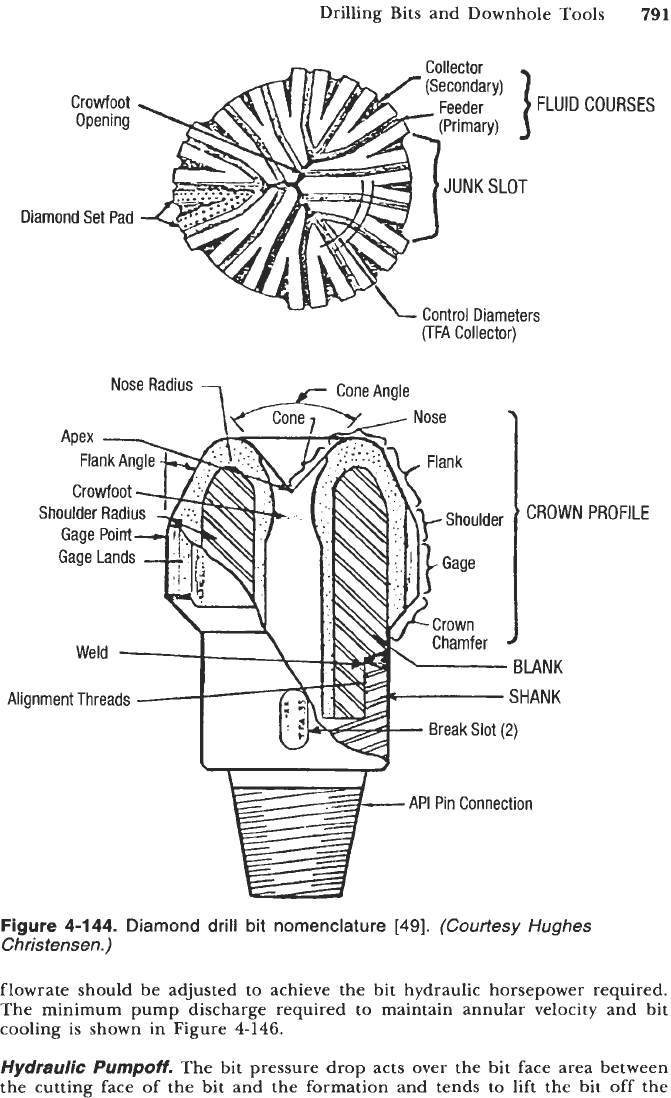
Crowfoot
Opening
Diamond
Set
Pad
Drilling Bits and Downhole
Tools
791
Collector
’
(Seconda
-
Feeder
(Primal
FLUID
’Y)
Iry’
3
SLOT
COURSES
Control Diameters
(TFA
Collector)
W
PROFILE
-
API
Pin Connection
Figure
4-1
44.
Diamond drill bit nomenclature
[49].
(Courtesy Hughes
Christensen.)
f lowrate should be adjusted to achieve the bit hydraulic horsepower required.
The minimum pump discharge required to maintain annular velocity and bit
cooling
is
shown in Figure
4-146.
Hydraulic
Pumpoff.
The bit pressure drop acts over the bit face area between
the cutting face of the bit and the formation and tends
to
lift the bit off the
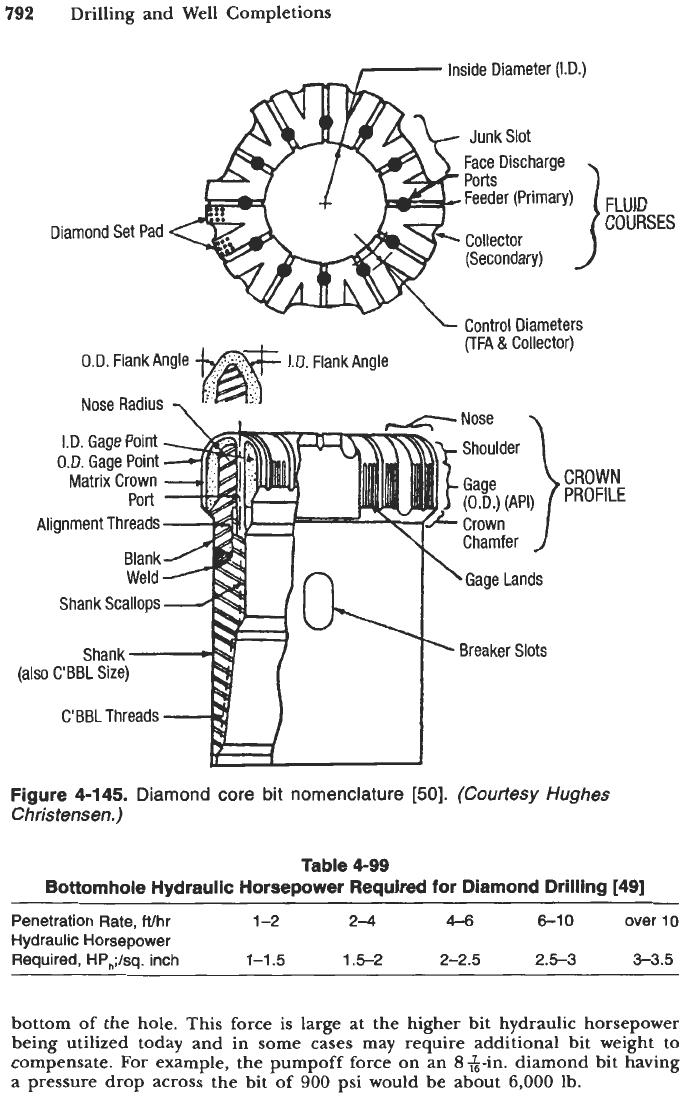
792
Drilling and Well Completions
I-
Inside Diameter
(ID.)
Diamond
Set
Pad
Junk
Slot
Face Discharge
Ports
f
Feeder (Primary)
Collector
(Secondary)
FLUID
COURSES
3
Control Diameters
(TFA
&
Collector)
Figure
4-145.
Diamond core
bit
nomenclature
[50].
(Courtesy Hughes
Christensen.)
Table
4-99
Bottomhole Hydraulic Horsepower Required for Diamond Drilling
[49]
~~ ~
Penetration Rate, Whr 1-2
2-4
4-6
6-1
0
over 10
Hydraulic Horsepower
Required, HPJsq. inch 1-1.5 1.5-2
2-2.5
2.5-3
3-3.5
bottom
of
the hole. This force is large at the higher bit hydraulic horsepower
being utilized today and in some cases may require additional bit weight to
compensate.
For
example, the pumpoff force on an
8
&-in. diamond bit having
a pressure drop across the bit
of
900
psi would be about
6,000
lb.
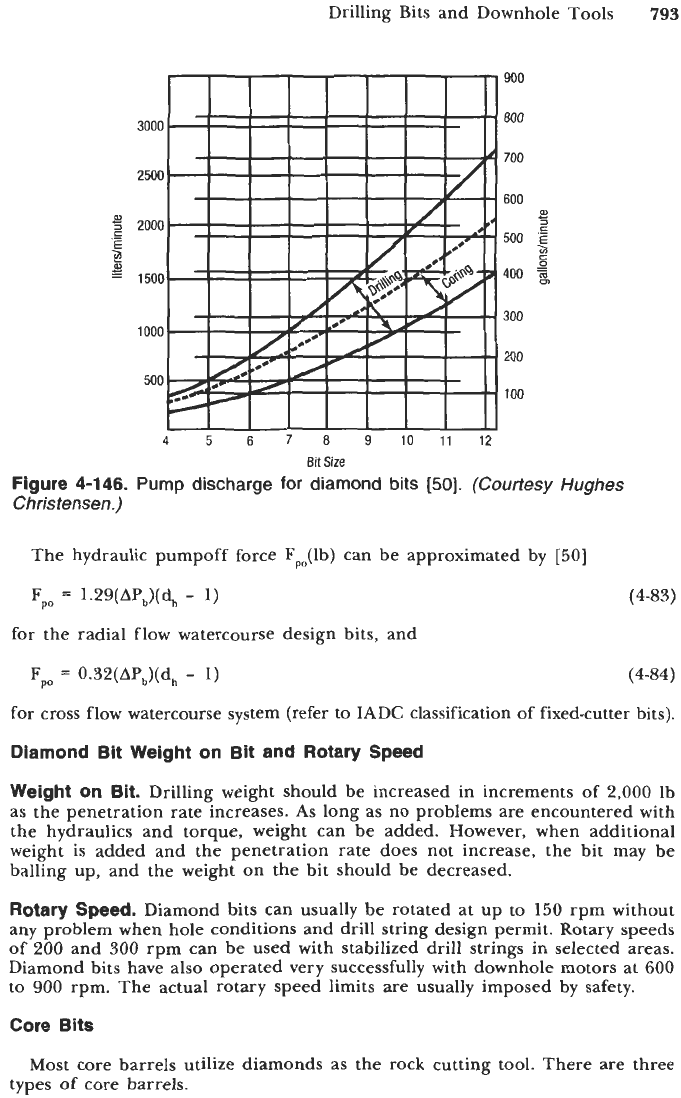
Drilling Bits and Downhole Tools
793
Figure
4-1
46.
Christensen.)
4
5
6
7
8
9
101112
Bit
Size
Pump discharge
for
diamond
bits
[50].
(Courtesy
Hughes
The hydraulic pumpoff force FJlb) can be approximated by
[50]
Fpo
=
1.29(APb)(dh
-
1)
(4-83)
for
the radial flow watercourse design bits, and
F,
=
0.32(APb)(dh
-
I)
(4-84)
for cross flow watercourse system (refer
to
IADC
classification
of
fixed-cutter bits).
Diamond Bit Weight
on
Bit
and
Rotary
Speed
Weight
on
Bit.
Drilling weight should be increased in increments
of
2,000
lb
as the penetration rate increases.
As
long as no problems are encountered with
the hydraulics and torque, weight can be added. However, when additional
weight is added and the penetration rate does not increase, the bit may be
balling up, and the weight on the bit should be decreased.
Rotary
Speed.
Diamond bits can usually be rotated at up to 150 rpm without
any problem when hole conditions and drill string design permit. Rotary speeds
of
200
and
300
rpm can be used with stabilized drill strings in selected areas.
Diamond bits have also operated very successfully with downhole motors at
600
to
900
rpm. The actual rotary speed limits are usually imposed by safety.
Core Bits
Most core barrels utilize diamonds as the rock cutting tool. There are three
types
of
core barrels.

794
Drilling and Well Completions
Wireline Core Barrel Systems.
The wireline system can be used for continuous
drilling or coring operations. The inner barrel or the drill plug center of the
core bit can be dropped from the surface and retrieved without pulling the
entire drill string.
Marine Core Barrels.
Marine barrels were developed for offshore coring where
a stronger core barrel is required. They are similar to the conventional core
barrels except that they have heavier outer tube walls.
Rubber Sleeve Core Barrels.
Rubber sleeve core barrels are special application
tools designed to recover undisturbed core in soft, unconsolidated formations.
As
the core is cut, it is encased in the rubber sleeve that contains and supports
it. Using face discharge ports in the bit, the contamination of the core by
circulating fluid is reduced. The rubber sleeve core barrel has proven to be a
very effective tool, in spite of the fact that the rubber sleeve becomes weak with
a tendency to split as the temperature increases about
175°F.
Core Barrel Specifications.
Core barrel sizes, recommended make-up torques,
maximum recommended pulls and recommended fluid capacities are shown in
Tables
4-100
and
4-101
[SO].
Table 4-100
Core Barrels: Recommended MakeuD Values
1501
--
Core Barrel Size
13.5
x
1.75 14.12
x
2.12 14.50
I
2.12 14.75
a
2.62 15.75
I
3.50
16.25
I
3
16.25
a
4 16.75
a
4
I
6.01
5.25
Racommended
1.700
3.000
5.000
4.050 7.400 14.900 8.150
9.900
19.OOO
Make
uD
Toraue
lo
to
to
IO
to
IO
Courtesy Hughes Christensen
Table 4-101
Core Barrels Characteristics
[50]
The Maximum Pull is
based
upon the ultimate
tensile strength in thapin threadarea with a
safety factor
of
thm.
Courtesy Hughes Christensen
